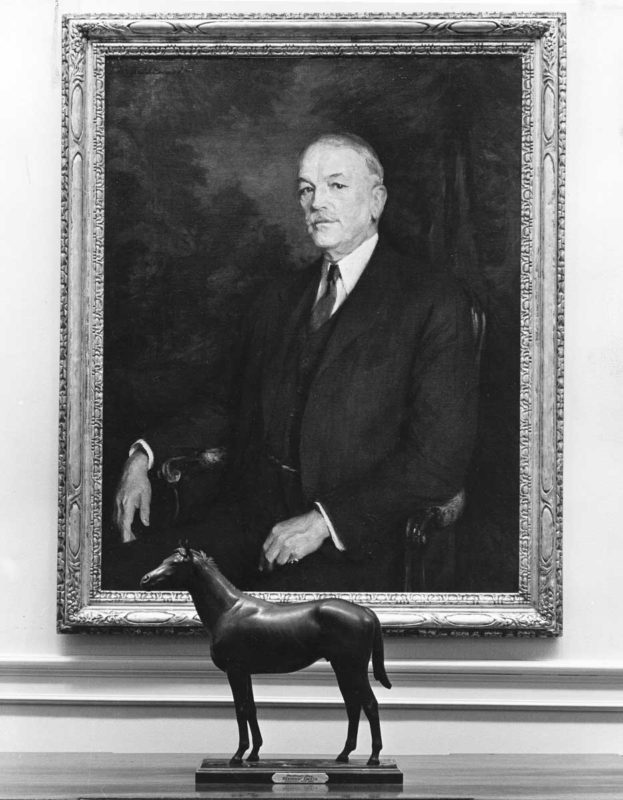
William Woodward, Sr. will be inducted into the National Museum of Racing’s Hall of Fame the month.
(first appeared in the August 2016 issue of The Equiery)
On August 12, Maryland will have another inductee into the National Museum of Racing’s Hall of Fame “Pillars of the Turf:” William Woodward, Sr.
A relatively new category, Pillars of the Turf honors individuals who have made extraordinary contributions to Thoroughbred racing in a leadership or pioneering capacity at the highest national level. Candidates must have represented the sport with indisputable standards of integrity and commitment through disciplines such as breeding and ownership, innovation, philanthropy, promotion and education. In 2015, another Maryland connection was inducted: famed breeder and owner of Sagamore and Pimlico Race Course, Alfred Gwynne Vanderbilt II.
Woodward will be inducted into the Hall of Fame during Saratoga’s famed summer season along with Arthur B. “Bull” Hancock, Jr., the racehorses Rachel Alexandra, Tom Ochiltree and Zenyatta; jockeys Ramon Dominguez and Wayne Wright; and trainer Steve Asmussen. The ceremony will be streamed live on the internet at www.racingmuseum.org from Fasig-Tipton at 10:30 a.m.
Woodward (1876-1953), who was born in New York City, became interested in racing during his youth; he attended the Belmont Stakes with his father as early as 1888. Even though he graduated from Harvard Law School and was admitted to the bar in 1901, Woodward decided not to pursue a career as an attorney. Instead, he opted to travel abroad, becoming the secretary to Joseph Choate, the United States ambassador to England. Returning to America in 1903, Woodward’s financial career led him to become president of Hanover National Bank in 1910 when his uncle, James T. Woodward, died. Along with receiving controlling interest in the bank, Woodward inherited the historic Belair Mansion and Stud in Maryland from his uncle.
In 1925, Woodward joined Claiborne Farm’s Arthur B. Hancock, Sr. and business moguls R. A. Fairbairn and Marshall Field to purchase Sir Gallahad III for $125,000. The import quickly became a prolific stallion in America, topping the sire list in 1930, 1933, 1934 and 1940, ensuring that Belair Stud and Maryland remained the cradle of Thoroughbred racing.
Sir Gallahad III sired a total of 60 stakes winners, of which nine were bred by Woodward, including Gallant Fox, winner of the 1930 Triple Crown. Gallant Fox in turn sired a second Triple Crown winner for Woodward, 1935 winner Omaha.
Along with his Triple Crown winners, Woodward won the Belmont Stakes three additional times in the 1930s with Faireno (1932), Granville (1936) and Johnstown (1939). Of his five Belmont winners, only Johnstown—a private purchase from Arthur Hancock, Sr.—was not bred by Woodward. Gallant Fox, Omaha, Granville and Johnstown were all elected to the Hall of Fame. After his fifth Belmont win, Woodward appeared on the cover of Time magazine’s August 7, 1939 issue.
Overall, Woodward bred 101 stakes winners, including seven American champions: Gallant Fox, Faireno, Happy Gal, Omaha, Granville, Vagrancy and Nashua. He also bred four European champions, Foxbrough, Hycilla, Black Tarquin and Prince Simon. Woodward-owned horses enjoyed considerable success in England, winning races such as the St. Leger Stakes, Ascot Gold Cup and Epsom Oaks. Woodward’s string in England was so successful that he was the second-leading owner there in 1937. Following his considerable success in the 1930s, Woodward bred and raced the champion Vagrancy in the following decade. The champion three-year-old filly and champion handicap female in 1942, Vagrancy added the Coaching Club American Oaks, Alabama Stakes, Ladies Stakes, Pimlico Oaks, Test Stakes and Delaware Oaks to Belair’s impressive trophy collection.
Along with his breeding and racing exploits, Woodward was a central figure in the sport’s leadership. From 1930 through 1950 he served as chairman of The Jockey Club. He was also instrumental in establishing the Coaching Club American Oaks and played a role in the development of the Grayson Foundation. During his time with The Jockey Club, Woodward, who was highly respected in England, convinced that country’s racing leaders to repeal the Jersey Act, which for generations kept many American horses out of the General Stud Book as purebred Thoroughbreds. In 1950, Woodward was elected as an honorary member of the British Jockey Club. Woodward was also a connoisseur of sporting art. His collection of more than 50 paintings of horses and racing scenes was donated to the Baltimore Museum of Art.
Woodward died in 1953 at the age of 77. Prior to his death, however, Woodward bred one final legendary racehorse, Nashua. Campaigned initially by his son, William Woodward, Jr., Nashua was a standout two-year-old in 1954 when he won the Futurity, Hopeful and Grand Union Hotel stakes. He was even better as a sophomore, winning the Preakness, Belmont, Florida Derby, Arlington Classic, Wood Memorial, Dwyer, and Jockey Club Gold Cup, as well as an historic match race with Swaps, to be named Horse of the Year. He later became the fifth horse bred by William Woodward, Sr. to be elected to the Hall of Fame.
Belair Stud is today a museum; to learn more about Belair, see the June 2016 Equiery article on great summer day trips!
For more information and photos of William Woodward, Sr., visit the National Museum of Racing and Hall of Fame website.
©The Equiery 2016










